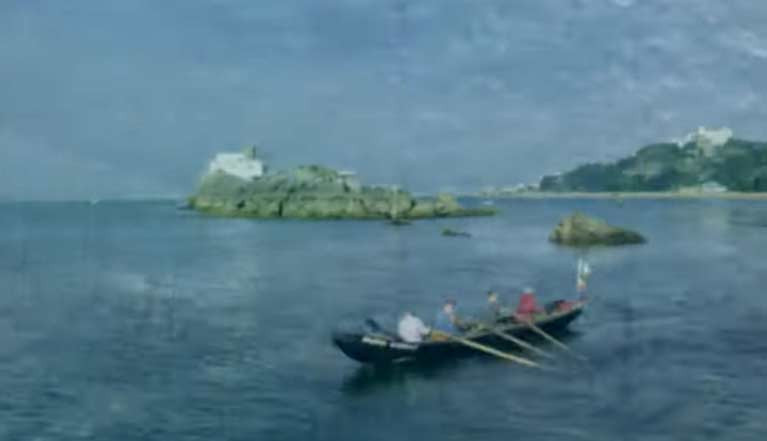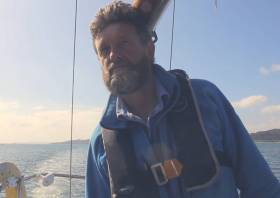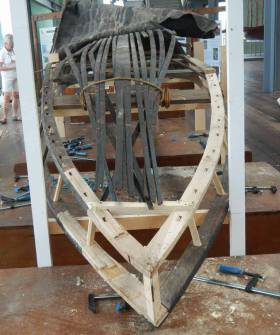Displaying items by tag: Danny Sheehy
A Medieval Galician poem is being re-imagined as a homage to the late Kerry sailor, poet and boatbuilder Dómhnall Mac an tSíthigh.
Mac an tSíthigh, also known as Danny Sheehy, died after a naomhóg in which he was one of four crew capsized off the Iberian coast in June 2017
The four were participants on Iomramh an Chamino 2017, which had left the Spanish port of La Coruña in late May bound for the Portuguese city of Porto in late June.
Internationally acclaimed singer and musician Liam Ó Maonlaí, renowned traditional singer and instrumentalist Breanndán Ó BeaglaoichSpanish-Czech singer Katerina García, and award-winning cinematographer Jaro Waldeck are among participants in an audio-visual project taking place in Dublin this Thursday, October 26th.
Cantiga I / Tonnta Farraigí Vigo is based on new interpretations and re-imaginings of the iconic Mediaeval Galician poem “Ondas do mar de Vigo” (“Cantiga I”) by Galician poet Martín Codax (mid-13th c).
It is described as the first of seven extant poetic compositions in the genre of cantigas d’amigo (songs/poems of the beloved) attributed to the poet and found in the manuscript Pergamino Vindel, now in The Morgan Library and Museum, New York (Vindel MS M979).
In this project, the original Galician text is presented for the first time alongside, and in dialogue with, its translation into Irish, by Ó Beaglaoich
This project takes place in Instituto Cervantes, Lincoln Place, Dublin, and it is co-funded by the Trinity Arts and Social Sciences Benefactions Fund. It is supported by the Department of Tourism, Culture, Arts, Gaeltacht, Sport and Media.
Full details are here
Musician Glen Hansard has paid tribute to west Kerry poet, farmer and sailor Danny Sheehy with a new video marking the third anniversary of his death.
Film-maker Dónal Ó Céilleachair, who recorded The Camino Voyage documenting Sheehy’s currach trip with the fellow crew from Ireland to northern Spain, has participated with Hansard in the video release.
Sheehy, an award-winning writer, died in June 2017 when the currach, Naomh Gobnait, was caught by a wave close to the Minho river estuary on the Spanish-Portuguese border. He was just 66 years of age.
Hansard said he wrote the piece, entitled Good Life of Song while staying at the Centre Culturel Irlandais in Paris.
“It’s a tribute to the life of bards and troubadours on their lifelong march through the towns and village of the world, singing and drinking, expressing the sorrows and joys of the age as they court darkness and light with equal knowing,” Hansard has said.
Hansard described it as a “song of gratitude for the gift of singing”.
“I raise it here to the memory of our boat captain, Danny Sheehy,” he said.
Ó Ceilleachair said that “in the face of all the challenges of the present moment, sometimes it is good to pause and give gratitude for the things we do have”.
“With gratitude to your contagious, magnetic, inspiring presence, Danny – Bail ó Dhia ort,” he added, marking the video release with Hansard.
Hansard signed up as crew for the final stage of the three-summer currach voyage from Ireland to northern Spain which was completed in late June 2016.
Sheehy and his close friend, west Kerry musician and oarsman Breanndán Ó Beaglaoich, decided to continue to navigate the Galician and Portuguese coasts in 2017, along with musician Liam Ó Maonlaí of the Hothouse Flowers and Co Cork boatbuilder Padraig Ua Duinnín.
The crew stayed with the upturned craft after its capsize, but Sheehy was taken ill on reaching shore and did not survive.
Better-known in his native Kerry as Domhnall Mac Síthigh, Sheehy won Oireachtas awards for his poetry and storytelling and was a broadcaster on Raidió na Gaeltachta and RTÉ Radio.
He had previously circumnavigated Ireland in a naomhóg with Ger Ó Ciobháin in 1975 and also rowed to Iona in Scotland, while also undertaking several sailing voyages west and north.
Reality Meets Myth In Author’s Adventure Along Ireland’s Coast
An encounter with late poet and sailor Danny Sheehy enlivens author Philip Marsden’s adventure along Ireland’s wild Atlantic way, as he writes for The Irish Times.
Marsden had set out to research a book about mythical islands — which took shape as his recently published The Summer Isles — when he was joined by Sheehy in Dingle for a revealing chat that took in everything from the intricacies of boat building to the dangers of the Irish coast that lay ahead.
As it happened, their meeting occurred just weeks before Sheehy lost his life after his naomhóg capsized off Portugal, while Marsden was navigating the Hebrides towards the end point of his own journey.
The Irish Times has much more on the story HERE.
Musician Liam O Maonlai Pays Tribute to the Restoration of the Naomh Gobnait & Late Poet & Crewmember Danny Sheehy
Musician Liam Ó Maonlaí says he believes the late Kerry poet Danny Sheehy would have “relished” the Irish-Galician project to restore the naomhóg in which he had his last sea trip before he died two years ago.
Ó Maonlaí, who was one of the four crew on board the Naomh Gobnait when it was hit by a wave in the river Minho estuary, has also spoken of how his mother, the late actress Eithne Lydon, had a “premonition” about his trip.
Sheehy, Ó Maonlaí, and fellow crew, Kerry musician Breanndán Ó Beaglaoich and Padraig Ó Duinnín, founder of Cork’s Meitheal Mara project, were swept ashore after the capsize on the evening of June 9th, 2017. Sheehy did not recover and died.
The four had been participants on Iomramh an Chamino 2017, which had left the Spanish port of La Coruña in late May of 2017, bound for the Portuguese city of Porto.
During the three preceding summers, Sheehy and Ó Beaglaoich, Liam Holden and Brendan Moriarty had rowed the naomhóg from Ireland to Spain – as documented by filmmaker Dónal Ó Ceilleachair - and were joined latterly by musician, Glen Hansard.
The naomhóg was taken into storage after Sheehy’s death, and now Buxa, the Galician Association of Industrial Heritage, is sponsoring its restoration.
“Danny would also have loved the fact that the boat is being honoured,” O Maonlái told Afloatthis week, noting that it marks a “connection that the Galician and the Irish people value a great deal”.
Ó Maonlaí first rowed with Sheehy when he was a 15-year-old during his time in the Kerry gaeltacht. After the “camino by sea” was completed in 2016, Sheehy invited the fellow musician to join the naomhóg for a week the following summer.
“I thought that was brilliant and I’d love to do that,”Ó Maonlaí recalls. “Meanwhile ,my mother was diagnosed with cancer and she got wind of this, and she didn’t want me to do it at all – west of Ireland woman, she had a premonition, and she really did not want me to go out on that boat”.
“And she said ‘why are you doing it, you’re just looking for trouble,’ “ Ó Maonlaí explains.
“And I said ‘c’mon Mam, you know’, you can imagine the conversation. But as she was ill and as it got closer to the time, I said I’d just do a day,” he says.
“ And so the day came, and we went out and then a wave came...”
His mother was “grand about it” afterwards, and it was not really spoken about again before her death in October of that year.
“ It was one of those things that actually was an intimacy between us,” he says.
The Hothouse Flowers co-founder and member of traditional group Ré also recalled this week how a “three quarters-full” wine bottle and a glass was found in Sheehy’s bag after their belongings were also swept ashore.
“It was like Danny left us with the bottle and the glass to drink in his memory..and that we did, with Máíre, his wife, and his friends and the crew. We sat around and we sang the odd verse of a song, “Ó Maonlaí says.
There is a tradition that a naomhóg or currach which loses a crew does not return to sea, and initially, there was talk of burning the boat, according to Breanndán Ó Beaglaoich, a close friend of Sheehy’s and one of the original camino crew.
However, Prof Manuel Lara Coira of the University of La Coruna, and president of Buxa, the Galician association of industrial heritage, secured support for it to be rebuilt.
Prof Lara explained that he had visited the Aran islands, loved Robert Flaherty’s Man of Aran film, and followed the Camino by sea – or “Naomhóg na Tointe” (naomhóg of the tents) as it was nicknamed when The Irish Times and other media reported on it.
When he saw the naomhóg coming into La Coruna, he said he felt so moved that he thought “my heart might jump out of my breast”. He admired the courage of the crew, and resolved to drum up support to have Naomh Gobnait rebuilt.
Prof Lara said he hopes to row in a traditional regatta in Spain later this summer, even at the risk of blisters on his hands and “other places”.
Liam Holden, Padraig Ó Duinnín and Brendan Moriarty have been working on the naomhóg rebuilt in northern Spain for the past fortnight, and plan to finish the work in the autumn.
Prof Lara said it will continue to be exhibited at the Galician Museum of the Sea, where a special exhibit on the Camino voyage opened earlier this month. Dónal Ó Ceilleachair’s documentary, The Camino Voyage, had its premiére in Vigo,
Ó Beaglaoich said he would like to see the naomhóg being displayed in the Irish College in Santiago de Compostella and believes the State should consider buying the building for cultural use – similar to the Centre Culturel des Irlandais in Paris, France.






























































